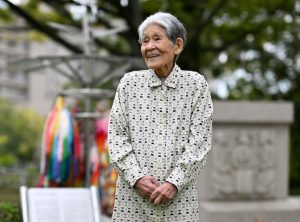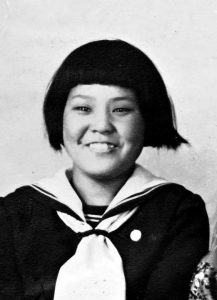Survivors’ Stories: Miyako Yano, 93, Nishi Ward, Hiroshima City—Having survived A-bombing, she placed the blame on herself
Nov. 4, 2024
Never allow education that instills the idea of “dying for the country” to happen again
by Hiromi Morita, Staff Writer
Miyako Yano (nee Ikeda), 93, served as director of the Hiroshima Prefectural Confederation of A-bomb Sufferers Organizations (chaired by Kunihiko Sakuma) and continues to communicate her atomic bombing experience to younger generations. She was a second-year student at Hiroshima First Municipal Girls’ School (First Girls’ School; now Funairi High School) when she was exposed to the A-bombing. The school lost a total of 666 students who had been mobilized to help demolish buildings near the hypocenter, including first- and second-year students, and 10 teachers. On that day, the 14-year-old Ms. Yano, who had been absent from school, was exposed to the A-bombing at her home, about 4 kilometers from the hypocenter. Though she survived, she faced a life burdened by the weight of survival and inhumane remarks from others after the war.
On August 6, 1945, Ms. Yano was at her home, Kanda Shrine, in Ujina (now part of Minami Ward) with her parents, two older sisters, and her aunt. She had been experiencing diarrhea since the night prior and had asked a friend who had come by to walk to school with her to submit a written note explaining her absence and remained at home to rest.
She sensed a sudden flash and was thrown into the air along with a tatami mat. Fragments of glass stuck in her legs, but she did not notice the injuries at first. When she went outside, she saw half the pine trees in the precincts of the shrine had been charred by thermal rays, and surrounding trees had fallen. A fireball had soon thereafter risen into the sky, the mushroom cloud expanded, and the area was engulfed in pitch darkness. After a while, people whose skin was red from severe burns fled to the shrine. “We couldn’t provide medical care but took in the wounded,” Ms. Yano said. “My family slept outside that night.”
What surprised her the next morning was that people who had seemed unharmed were now dead. With no knowledge of radiation, she had no idea what had happened. The bodies were cremated in a nearby open space, and Ms. Yano tended to the fire.
In September, Ms. Yano returned to school after some time away and learned her classmates, who had been mobilized to help demolish buildings, had died. Even the teachers called out to her “Hey, survivor!” and the families of her friends blamed her, saying, “The children who worked hard had died, and a slacker survived.” The weight of this guilt overwhelmed her, and she tried to drown herself in the river many times but could not go through with it because she was a good swimmer. She said, “I felt guilty about being alive, and all I could think about was dying.”
When she was around 17, she began suffering from severe anemia, and in her 20s, her teeth suddenly started falling out. Whenever she felt something unusual with her body, she was worried, wondering if it was due to the aftereffects of the A-bombing. But she stayed secluded at home, feeling a debt for surviving.
Nineteen years after the A-bombing, Ms. Yano first read a memoir by the family of an A-bomb victim who had lost a sister who was a first-year student at First Girls’ School. She thought if the A-bomb had been dropped just a day earlier, she would have died like her. She decided to make the most of her life and do whatever she could because she had survived.
Ms. Yano was introduced to Misao Nagoya (who had written the memoir and died in 1986 at the age of 56), by an acquaintance, and began accompanying her when she gave testimonies. Ms. Yano also participated in dictating A-bomb survivors’ experiences. One day in the 1960s, she began sharing her own A-bomb account with others after stepping in for Ms. Nagoya.
Ms. Yano was born in 1931, the year the Fifteen Years War (the series of wars between the invasion of Manchuria and the end of World War II) began. She described the mobilized students who were killed directly beneath the explosion’s center as those who had known life only in wartime. She said, “We were taught to memorize war songs and the Imperial Rescript on Education, which told us to dedicate our lives to the emperor in the event of war, and dying for the country was natural. I never thought about surviving.”
She shared her painful memories, hoping the younger generation will never experience the same suffering. She said, “Because I survived, I understand how many lives were wasted in the war. Think about who is fighting and why, and do what you can to help stop it.”
(Originally published on November 4, 2024)










